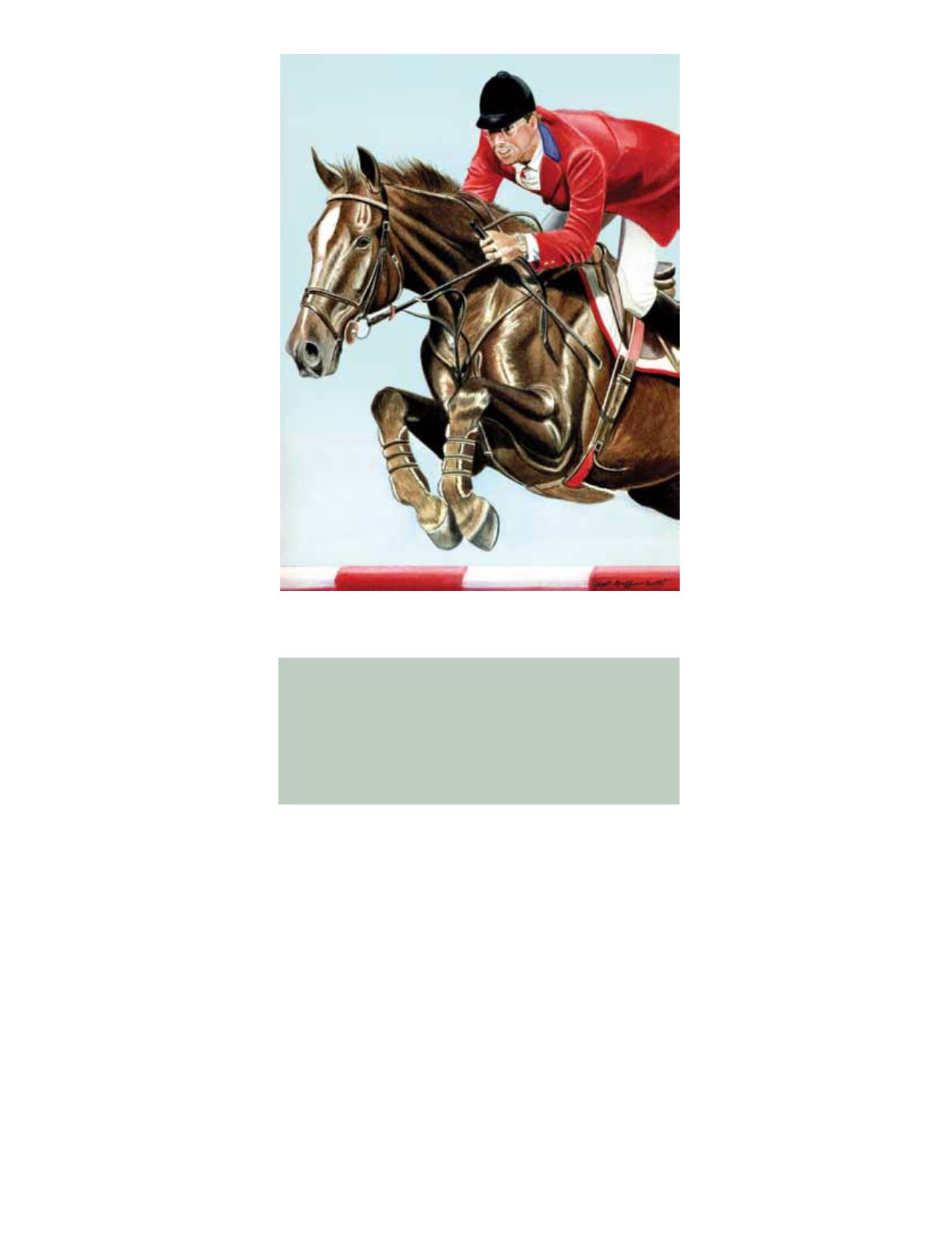
122 SIDELINESMAY 2014
FORHORSEPEOPLE • ABOUTHORSEPEOPLE
Continued on page 124
ByDorisDegner-Foster
I
an Millar’s journey is a
long one. He became a
member of Canada’s show
jumping team in 1971, and has
maintained a place on the team
ever since - which has helped
him earn the nickname “Captain
Canada.” He holds the record
for participating in 10 Olympic
Games, more than any athlete in
any discipline. At age 67, Ian still
hasabusy schedulebasedat his
farm in Perth, Ontario, Canada,
working with his daughter, Amy,
and son, Jonathan, who also
compete and train actively most
of the year. Sidelines caught up
with himwhile hewas competing
at theWinter Equestrian Festival
inWellington, Florida.
When training, Ian’s philoso-
phy is getting the horse and
rider to be the best they can be,
whatever that is, according to
their abilities. “I always hope that
every rider or staff member who
has spent time at our farm, Millar
Brooke,will lookbackat that time
in a very positivemanner, realiz-
ing that we have done the very
best for them and their horses,”
he said. “When I wander around
thePalmBeachEquestrianCen-
ter, I see many former students
or employees. They are all great
friends and I enjoy seeing them.”
Ian stressed that attitude in
a horse and rider are critical to
success. He said about train-
ing, “You have the opportunity
to learnmore from the problems
and the challenges the horses
and riders have. I believe very strongly in constantly learning and
appreciating the journey because the destination is unpredict-
able.”
Early in his career, sports psychology was not yet popular. At
that time, riders learned on their own how to deal with the pres-
sures of competition, learning through experience. Ian explained,
“I figured out that with every horse and every rider there was an
optimum stress level. If you’re below it, you’re not going to be
sharp enough and if you’re above it, nerves will interfere with re-
sults.” He laughed, then went on to add, “So you have to learn
how to put yourself right in that optimum range of stress. The day
I stopbeingnervous is theday I don’t careenough. I welcome the
pressure and stress that comewith big competitions.”
Of course, Ian is no stranger to big competitions. In addition to
riding in 10 Olympic Games, he won the Canadian Show jump-
ing Championship nine times and won the prestigious Spruce
Meadow Derby in Alberta, Canada, six times. Riding his leg-
endary horse, Big Ben, Ian won more than 40 Grand Prix titles
worldwide, including twoback-to-backWorldCup finals, thepres-
tigious Spruce Meadows Masters Grand Prix, and an individual
gold medal in the Pan American Games. In the Pan AmGames
inWinnipeg in 1999, hewon another goldmedal in an incredible
come-from-behind victory rid-
ing a horse named Ivar, and the
team bronze medal. It wasn’t
until the 2008 Olympic Games,
however, that he won an Olym-
picmedal,winning teamsilver at
theageof 61.
In addition to his recognition
within the horse sport, he is a
member of the Order of Cana-
da, the highest civilian award
given by the Canadian govern-
ment, and has been inducted
into the Canada Sports Hall of
Fame and Ontario Sports Hall
of Fame. He holds an honorary
doctorate from the University of
Guelph,Ontario, VeterinaryCol-
lege.
About 25 years ago, when he
was in his early 40s, Ian was
asked in an interview how long
he would continue to ride and
compete at the top level. He
answered that he would like to
compete on into his 50’s, and
thenhe’d seewhere thingswent
from there. Ian shared an an-
ecdote about his late wife Lynn
when he said, “My wife once
said tome, ‘Makemeapromise.
Only do this if it’s still fun, and if
it stops being fun, I want you to
stop.’ I’ve kept that promise.”
Obviously, Ian is still having
fun. He explained that problems
that are a source of stress and
frustration need to be solved
quickly and eliminated, but that
he fully embraces positive chal-
lenges. He said, “My basic phi-
losophy is, I’ll never quit trying
until I succeed, and I never give
up.”
Ian’s tenacity is evident in how heworks tomaintain his physi-
cal fitness. He spoke again of the early years of his career when
he said, “We didn’t have access to personal trainers. I had, as
so many riders do, some lower back issues. During the course
of my research I learned the importance of core strength and the
balance between abdomen and back muscles. I immediately set
about developingastretchingandstrengthexercise regimewhich
I do every morning and I never miss a day. That’s in addition to
ridingandworkingat the shows, or around the farm.”
Ian stressed that the longevity of a riding career is dependent
upon good riding basics and a classic style. As the sport has
evolved, the attitude of the horse has become more important.
Today’s coursedesigns requirea very sophisticated level of train-
ingand riding. That requires a horsewith a goodmind.
“Attitude is paramount,” Ian said emphatically. “Inmodern-day
competition, no matter what level, the horse must be a positive,
generous, willingpartner. Ahorse is poweredby his lungs, perse-
vereswithhis heart andwinswith hismind.”
To be a successful competitor in this day and age, the horse
must be the consummate athlete. He must possess a very ad-
justable stride, impeccablebalance, power, techniqueand speed.
Riding his legendary horse, BigBen, Ianwon
more than40GrandPrix titlesworldwide,
including twoback-to-backWorldCup finals,
theprestigiousSpruceMeadowsMasters
GrandPrix, and an individual goldmedal in
thePanAmericanGames.
A paintingof Ian andhis famous equine partner, BigBen, by
Canadian artist Janet Griffin-Scott.
Courtesy of Janet Griffin-Scott,


